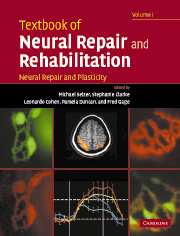Book contents
- Frontmatter
- Contents
- Contents (contents of Volume II)
- Preface
- Contributors (contributors of Volume I)
- Contributors (contributors of Volume II)
- Neural repair and rehabilitation: an introduction
- Section A Neural plasticity
- Section A1 Cellular and molecular mechanisms of neural plasticity
- Section A2 Functional plasticity in CNS system
- Section A3 Plasticity after injury to the CNS
- Section B1 Neural repair
- Section B2 Determinants of regeneration in the injured nervous system
- 21 Inhibitors of axonal regeneration
- 22 Effects of the glial scar and extracellular matrix molecules on axon regeneration
- 23 Trophic factors and their influence on regeneration
- 24 Intraneuronal determinants of regeneration
- Section B3 Promotion of regeneration in the injured nervous system
- Section B4 Translational research: application to human neural injury
- Index
24 - Intraneuronal determinants of regeneration
from Section B2 - Determinants of regeneration in the injured nervous system
Published online by Cambridge University Press: 05 March 2012
- Frontmatter
- Contents
- Contents (contents of Volume II)
- Preface
- Contributors (contributors of Volume I)
- Contributors (contributors of Volume II)
- Neural repair and rehabilitation: an introduction
- Section A Neural plasticity
- Section A1 Cellular and molecular mechanisms of neural plasticity
- Section A2 Functional plasticity in CNS system
- Section A3 Plasticity after injury to the CNS
- Section B1 Neural repair
- Section B2 Determinants of regeneration in the injured nervous system
- 21 Inhibitors of axonal regeneration
- 22 Effects of the glial scar and extracellular matrix molecules on axon regeneration
- 23 Trophic factors and their influence on regeneration
- 24 Intraneuronal determinants of regeneration
- Section B3 Promotion of regeneration in the injured nervous system
- Section B4 Translational research: application to human neural injury
- Index
Summary
Keywords
- Type
- Chapter
- Information
- Textbook of Neural Repair and Rehabilitation , pp. 421 - 442Publisher: Cambridge University PressPrint publication year: 2006
- 1
- Cited by

